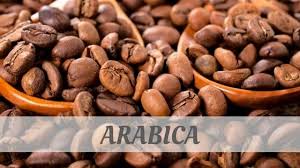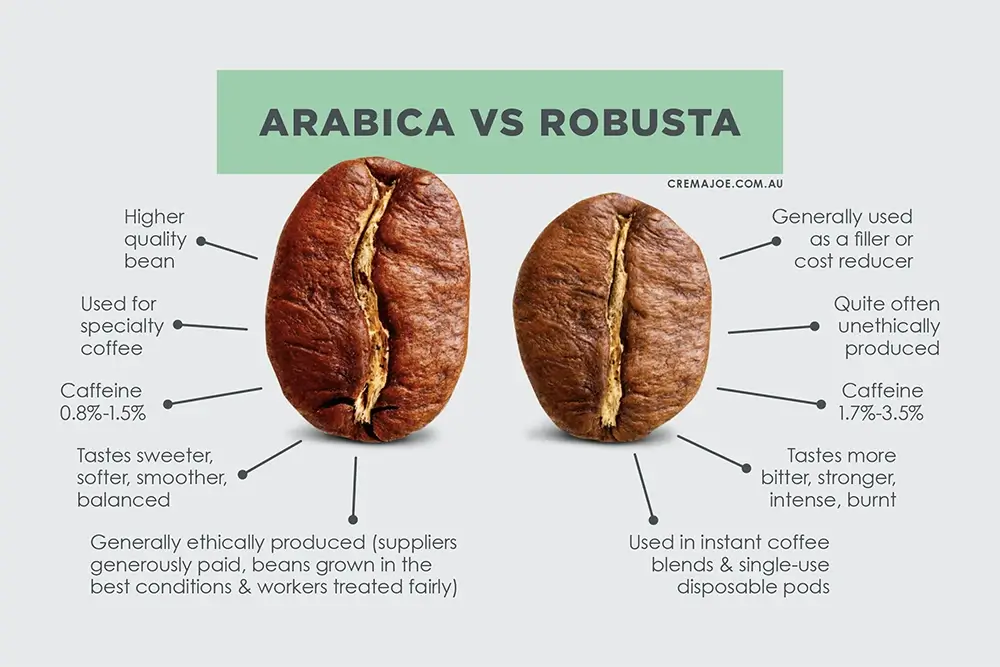
For those that are not very knowledgeable about the world of coffee, you may find out that more than one type of coffee bean even exists!
To be specific you could find more than 120 distinct types of coffee beans and plants being grown today. But today, there are only a few that actually makes it to the market in mass quantities
That being said, I’m only going to focus on the two most popular and known coffee beans, Caffea Arabica and Caffea Canephora, commonly referred to as Arabica vs. Robusta coffee beans respectively, and what makes them different from each other.
What is Arabica Coffee?

Arabica beans covers about 60% – 70% of the world’s coffee production and has been regarded as being a better tasting coffee.
The results of coffee taste, depth, and aroma flavor of coffee beans depend mostly on their origin, processing, method, and other factors.
Arabica coffee beans must have higher elevations for growth. As a rule, Arabica bean is grown between 600 meters to 2,500 meters. A higher elevation to grow Arabica is more difficult to grow, but it adds to the complex flavor and greater acidity of the coffee.
Some roasters and manufacturers are letting consumers known the elevation data information on their coffee bags. Arabica coffee requirement of higher elevation will slow down the growth which impacts production and ultimately increases cost.
There are different levels of Arabica, and the highest level of this Organic coffee bean provides the following:
– One pure ingredient (Not Blended)
– Single-origin (comes from one location only)
– Mycotoxin Free (Mold Free)
– Shade Grown (sun filtering canopy improves the quality of the coffee bean)
– the Highest elevation (at least 5,700ft above sea level)
– Fair Traded (grown in a sustainable environment)
– Specialty Beans (world’s coffee yield or the TOP 3% of global production)
– Non-GMO (not been genetically modified)
– Kosher Certified (certify this coffee bean to Orthodox standards)
What Is Robusta Coffee?

Robusta Coffee comes from Coffea canephora plant, the origins of this coffee bean comes from the African continent.
Robusta coffee bean has a bitter taste and is used primarily in instant coffee, espresso, and as a filler in certain blends of ground coffee.
With a reputation for lower quality, Robusta is less popular with specialty coffee lovers. But if it’s grown and processed with a focus on quality, could it make a delicious cup? It definitely can be achieved.
Robusta has been wrongfully criticized for having rubbery notes and bitterness that may be related to its higher caffeine content. Specialty roasters and brewers have mostly dismissed it. It’s usually destined for the less expensive part of the market and is often used in coffee blends.
It’s mostly and successfully used in instant coffee and espresso blends. So if espresso is your chosen coffee at home, you’ll want to choose the best in Robusta beans to brew a high-quality espresso with a rich depth in flavor or an Arabica/Robusta blend for an increased crema espresso.
It’s easy to say that if Robusta beans were given the same care and attention as Arabica crops, it would result in higher quality and more respect for this coffee type.
In the business world economics, it’s about demand and supply, and if there is a low demand for fine Robusta, farmers have little incentive to invest money and time to improve the quality at the farm level.
What Are the Differences Between Arabica and Robusta?
 Arabica coffee plants take between 5 to 7 years to fully mature while a Robusta plant can take anywhere from 2 to 3 years. So small and beginner farmers are taking risks and takes longer for profitability planting Arabica trees because they are essentially investing for the longer term.
Arabica coffee plants take between 5 to 7 years to fully mature while a Robusta plant can take anywhere from 2 to 3 years. So small and beginner farmers are taking risks and takes longer for profitability planting Arabica trees because they are essentially investing for the longer term.
The growing process is also more intense which adds to the total farming expense which places added pressure and costs on their business which results in higher green bean prices
We established that Arabica beans grow at higher elevations for a successful yield. A typical Arabica bean is grown between 600 meters to 2,500 meters. A higher elevation usually carries added costs because it adds to the complex flavor and greater acidity of the coffee.
Currently, many roasters and manufacturers have started to place the elevation data on their coffee bags. The higher the elevations, the slower the growth which impacts farming and ultimately increases production cost.
Robusta coffee inherently has twice as much caffeine and chlorogenic acids as Arabica. These factors have a distinct effect on the taste of the coffee.
Generally speaking, a Robusta bean has a more bitter, woody, and leathery flavor, which researchers attribute to the higher levels of caffeine and chlorogenic acids.
The higher caffeine level has a biological reason which protects the Robusta coffee with pest control. Robusta beans have a higher resistance to pests and
insects based on the increased amount of caffeine which is a natural deterrent to pests.
With lower caffeine levels in Arabica beans, it makes it more prone to insect crop damage and requires a lot more care and maintenance. These factors result in higher green bean prices, which makes Arabica a higher-priced coffee.
What are the main differences between Arabica vs Robusta Coffee? Arabica coffee has usually a much lighter taste, fruitier flavor, and higher acidic content, and with more of a floral taste and aroma.
Robusta beans are heavier in-depth, woodsier taste earthier in flavor, and more tannin which causes higher bitterness. Arabica and Robusta Coffee also have varying levels of caffeine, sugar, lipids, and antioxidants. I itemized the main differences below for clarity.
– Brewed Robusta Coffee using an espresso machine results in a thick crema coffee
– Arabica also has more nuanced flavors than Robusta. Fruity, chocolaty, nutty, and other notes are found in Arabica coffees
-instant coffee is made from Robusta beans
– The Robusta bean is around 2.3- 2.8% caffeine, and the Arabica bean is around 1.1 – 1.6%.
– Arabica has almost twice the amount of sugar
– Robusta has less acidity than Arabica
– Arabica has more lipids
But the main difference that most coffee lovers care about is the fact that Arabica coffee is smoother, and tastes better than the bitterness in a cup of Robusta! Although Arabica is pricier, it’s worth it if you want to enjoy your morning nectar of God.
No contest! If you have the choice between an Arabica or Robusta bag of coffee, it’s important to always choose Arabica, unless it’s for instant coffee or a blend of Arabica and Robusta for delicious espresso types of coffee brew.
 Takeaway
Takeaway
And the winner of this wonderful information is… us, the coffee lovers! Understanding the basic differences between Arabica coffee and Robusta coffee can have a huge impact on your preference for your cup of Joe.
For all coffee lovers that want the best tasting and most flavorful coffee, I believe Arabica is the coffee that perfectly satisfies your coffee cravings. If espresso is your coffee passion, you can choose a blend of Arabica/Robusta, for a stronger flavor, depth, and forming a rich crema for an incredible espresso.
For instant coffee aficionados, Robusta is the correct coffee product for you. For those organic and healthy-minded coffee lovers who also crave the best tasting and flavorful coffee, the choice would be the Arabica Organic coffee.
In other words, coffee taste is subjective, and there is a great coffee type on the market that fits everyone’s perfect coffee needs and taste.
Happy sipping!
If you have any comments, please leave them below, I’d love to hear from you. If you’re a coffee lover and a dog lover check these pet supplements.

 Takeaway
Takeaway
Hello there, From What I know, Arabica tends to have a smoother, sweeter taste, with flavour notes of chocolate and sugar. They often also have hints of fruits or berries. Robusta, on the other hand, has a stronger, harsher and more bitter taste, with grainy or rubbery overtones. Thanks alot for sharing this awesome article.
Thank you for your comments .
Michael
The is a great comparison you have here. Comparing two of the best coffee beans in the world is really nice. Indeed, we – the coffee lovers are the winners here. Having such information has increased my knowledge about coffee beans. And will also have a great impact on types of coffee I drink. Great job on this one.
Thank you Nelson for your comments. I’m a coffee lover also, and knowing which beans will make different types of coffee enhances ones coffee pleasure. Thanks
Michael
Hello there!
You’ve got an awesome and super amazing piece there. Until now I never knew there are varieties of coffee beans talkmore of knowing there are about 120 different coffee beans been grown today. I glad I have added this knowledge, I believe the beans there has delicious and very nice coffee to offer, deducing from that review.
thanks
Hi Caro,
Thank you for your comments on the post, and I’m glad you found my article interesting. Let me know if you have any additional questions Thank you
Michael
Well I love coffee so it’s very cool to learn more about the different kinds of beans that coffee comes from. I didn’t know that Arabica beans make for a better tasting coffee. I also didn’t know that they use Robusta beans for espresso. This article was very interesting and I know a lot of people will enjoy it as much as I did
Melanie, thank you for your comments. I’m glad you enjoyed the article, and provided informative info. I use both kinds of beans based on the coffee I’m drinking. Thank you
Michael